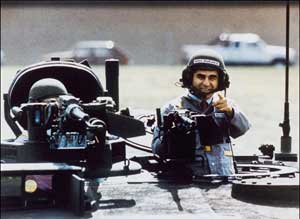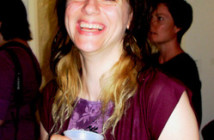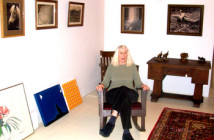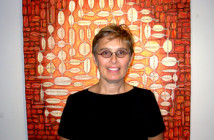These are tough times for bleeding hearts, tax and spend, liberal Democrats from Massachusetts. You know, the ones, way back when, who voted for Mike Dukakis, when he carried just his home state in a presidential race against George The First. The devastating image, that time, was Mike in a tank looking like a ninja turtle. There were other Republican dirty tricks like the specter of Willie Horton on early release raping and murdering your loved ones. Crimes for which Dukakis, famously, would not impose the death penalty. This time, the Republicans must have laughed about that absurd last minute news clip of Kerry in camouflage shooting a goose. Or, last summer, wind surfing off Nantucket. The nation that wind surfs together stays together? As Robert Duvall said, “Charlie don’t surf.”
So there was a gloom and doom yesterday as I dragged myself around town to check out exhibitions. I had missed the gala openings the night before because I was a featured speaker at the Dante Alighieri Society of Massachusetts, in Cambridge, honoring the opening of an international exhibition “Sostenibili Leggerezze” the last stop of a five venue tour that started in Prezza, Italy in August. I wrote the catalogue essay for John D. Gentile, and the Italian critic, who translated my essay for the catalogue, Paola Gasbarrini, wrote about the widely exhibited artist, Massimina Pesce. Paola gave a lively critical analysis of both artists at the festive event. The artists were both born in Prezza, the sponsor of the exhibition, but Gentile has spent his adult life in Lynnfield, Massachusetts. I was brought into the ambitious, multi-national project by the gallerist, Sunne Savage, whose husband, Robert S. Neuman, is opening an exhibition “Selections- 1951-2004- Paintings and Drawings” at the John Raimondi Gallery, 80 City Square, Charlestown this Monday.
There was a kind of morning after feeling in the South End. Reports of galleries being crushed with revelers. The occasion marked the dedication of numerous newly renovated spaces in a large cluster of galleries at 450 Harrison Avenue. The site has resembled the Big Dig for the past couple of years. Boston finally has a first class, vital and expanding gallery district. While it is located in an old warehouse district, on the fringe of the upscale South End, high rise luxury buildings are popping up everywhere.
While the business potential is upbeat the psychic mood was grim. Gallerist Bernie Toale, who tends to be cool and aloof, disclosed that he was feeling “Grumpy.” I suggested he team up with the six other dwarves. That brought a smile to his somber face, but he added that his partner, Joe Zina, has threatened not to get out of bed until there is a Democrat in the White House. Joe may be the next Marcel Proust. While we shared a few laughs there is nothing funny about the next four and more years. My gallery tour ended in the back room of Kidder Smith where Tom Smith, sprawled on the floor nursing a Coors Light, waxed rhapsodic about the state of the nation in a monologue of Ali G outtakes. Tom is a truly gifted raconteur.
Before we start to discuss some of the outstanding exhibitions now on view, let me remind you of the last chance to check out the amazing work of visionary artist, Paul Laffoley, at the New England School of Art & Design, Suffolk University, 75 Arlington Street, Boston. While the show received an outstanding feature review by Lisa Falco, in Arts Media, it is deplorable that this rarely seen Boston based artist, with a national and international reputation, was stiffed by the Boston Globe. Although I curated the exhibition, the artist’s first Boston solo since the relocation of Stux Gallery some 20 years ago, I would never claim that I understand the work. The more important word is respect. Truly, Laffoley is one of our most important national treasures.
Ralph Hamilton: New Work
Kidder Smith Gallery
131 Newbury Street
Through November 27
Gallerist Tom Smith is high end, high maintenance, and high concept. Conservative Boston does not truly deserve this brilliant and witty entrepreneur. For me, however, it wasn’t always this way. Tom grows on you. His first show sucked, and I told him so. In the beginning he showed mostly California pop artists, still does. Hey, it sells. His shows mostly appeal to baby boomers who stroked to Betty Page when they were teens. Why not. I accused him of being a Carpet Bagger because he ignored local artists. We didn’t start well, which he loves to remind me, but Tom has come a long way. Today, several years later, he may be our best and brightest gallerist.
For one thing, he knows that it pays to advertise; usually a full page ad in Art in America, or occasional insertions in Art Forum and other national magazines. Invariably, the work illustrated in the ad sells so it pays for itself. As is the case this month, with a large format, grisaille, blurred portrait of the brilliant but skittish actor, Montgomery Clift, by Ralph Hamilton. The day after the opening, the painting was sold, along with a self portrait, both to the same collector. This marketing strategy gives Smith and Boston a national and international presence. Last summer, he opened a gorgeous space on posh Martha’s Vineyard. Smith tends to go where the money is.
This week, he’s off to LA for more pop studio visits and then on to Miami for the art fair first week in December. Somewhere in between he promised to take me to dinner at Pappa Razzi. After all this promo he can do better than that. Just kidding.
His eye gets sharper all the time and is slowly catching up to his tongue. For instance, the decision to show Hamilton, and last season, Miroslav Antic, now relocated to South Florida, both major but underappreciated artists, is brilliant and poignant. This is Hamilton’s first solo gallery show in ten years, since Miller Block, and regular representation, way back when, by the esteemed former Thomas Segal Gallery. There was a time, in the 1960s, when Hamilton was regarded as a prodigy.
Like many regional artists he was too hot not to cool down. There is a familiar problem of having sold to the handful of serious local collectors. Then what? Also, his technique resembles that of Gerhard Richter. Ralph has been painting in this manner forever. But there is always the chicken/ egg conundrum.
Hamilton makes large format renderings of appropriated photographs. They are reductive in palette and, yes, blurred with swipes of a dry brush. One has to look deeply into his unique subject matter and intentionality. A blur, upon inquiry, turned out to be the swing of Joe Dimaggio. Lost on me, as I was never a Yankees’ fan. There are several disaster subjects: A sprawling murder victim, and an execution. Celebrity portraits, like Jonathan Swift, and other historical vignettes. This is compelling and powerful work. Locally made. Bravo.
South End
450 Harrison Avenue, unless otherwise noted.
German Indians
Andrea Robbins and Max Becher
Bernard Toale Gallery
Through November 27
The photographs of Germans absurdly playing dress up as Sioux Indians was readily familiar from their inclusion in the critically trashed Whitney Museum exhibition “The American Effect,” in 2003. That project, which I for one mostly liked, focused on global interpretations of aspects of American culture. It was discussed as a movement of National Geographic art.
This body of work derives from the annual, birthday pow wow held in Radebeul, near Dresden, honoring the 19th century, dime novelist of the American West, Karl May. His populist writing had an enormous impact on German culture as I learned in a lecture by the historian, Wanda Corn, at the Clark Art Institute, through her research on the early work in Germany, at the outbreak of World War One, by the American artist, Marsden Hartley. Indian folk kitsch was a part of the decorative scheme of Hartley paintings that paralleled the more compelling German Military Series of that era.
But here we do not enjoy the luxury of the filtering of the material from one medium to another. Instead, we are confronted by ironic images of Teutons in Teepees. There is a slavish attention to minute detail in the costumes which are European produced simulacra of vintage museum pieces. The European fascination with Native Americana has a noble history from Rousseau to Chateaubriand and in its popular kitsch form as the novels of May and silent film, serial melodramas.
While the subject matter is absurdly compelling does that obscure their aesthetic valuation? In creating work of artistic merit the subject matters but there are other factors. Other than the goofy getups and pratfalls there is the gnawing feeling that these photographs, in every other sense, are ordinary. They are just anecdotes added to a long corpus of works from the paintings of George Catlin, to the photographs of S. D. Curtis that explored this material in loving depth.
Harry Callahan: Fifty Photographs
Gallery Kayafas
Through November 27
This is a stunning, museum level survey of all aspects of the work of Harry Callahan, one of the most important photographers of his generation. It is a real coup for the gallery to launch its dramatic new space with this phenomenal, in depth exhibition drawing on significant phases of the artist’s career, from the early works, such as the icon of his swimming wife “Eleanor, Chicago,” 1949, through large format works from his late years as a professor at Rhode Island School of Design.
The exhibition grew out of a close relationship between the husband of the gallerist, who was a student of Callahan’s, and assisted in printing the large format, late works. They remain close to his widow, Eleanor, who provided most of the works in the exhibition. The prints range in price from $6,500 through $20,000. But we are talking about icons of 20th century American photography. Let us hope that a number of these works find their way into New England collections.
Many of the signature images are nude studies of his full figured wife with a tendency to formal abstraction rather than the erotic. There is always an understated simplicity and humility to the photographs. It is resonant and powerful work.
Jim Peters: New Paintings and Constructions
MPG Contemporary
Through November 27
The nude, female figures of Provincetown based artist, Jim Peters, have always been well painted, evocative and pleasing to the eye. It’s just that over more than a score of years of looking at them there never seems to be any significant change or development. He is a good painter, to be sure, but never seems to become a better artist. The work hit a plateau, an elevated one, but has just cruised along since then. These women lost their erotic fascination decades ago. It’s like running into an old girlfriend. Nice to see you again but the embers are cold. The work needs a dose of Viagra.
Pia Schachter: Defiance
Allston Skirt Gallery
Through November 27
Don’t get me wrong, I love Pia Schachter, one of Boston’s enduring good/bad girls, and Allston Skirt, a terrific gallery now in its wonderful new home, but this time, sorry, less so.
Frankly, I was surprised to learn that this was Pia’s new work. The straight no chaser photographs in large format, rich saturated color, histrionic poses, of heavy metal rockers in performance and back stage, reminded me of Slater Bradley, but without the irony. No send up doppelgangers of Kurt Cobain here. Once again, as stated previously, there is a paradoxical struggle between the subject matter, whether or not it proves to be compelling, and the formal aspects of the aesthetic impressions. So I don’t know where she is going with this. The work feels very young but the artist is actually more mature than that. Perhaps it is time to stop clubbing and get back into the studio to do some new work.
Michael Scoggins
Samson Projects
Through November 27
This is the new space of gallerist Camilo Alvarez which has the potential to bring an edgy program to often stodgy Boston; if we are to go on the basis of this exhibition featuring the cartoon paintings of Michael Scoggins. They are large, colorful, inventive canvases but far too literal, jumbled and crudely cartoony for my melancholic taste. Undoubtedly, they will be more appealing to the core audience of this youthful gallery.
Calvin Brown: Paintings 1978-2004
Genovese/ Sullivan
Through December 1
The gallery was a pioneer at this location, way back when spaces were larger and cheaper than now. The gallery has moved into what appears to be a double wide space in keeping with their long held mandate. The program has favored aspects of reductive abstraction. Here represented by an overview of works by Calvin Brown. There is one large wall devoted to flat, Op, eye dazzling designs. The work is strong and consistent. It is instructive to see the process of development from then, more expressionist, to now, quite pure and refined.
Peter Lipsitt: Tangent Links
Boston Sculptors Gallery
486 Harrison Avenue
Through November 27
I have appreciated the work of Peter Lipsitt since the 1960s when we were students in the studio of Peter Grippe at Brandeis University. From there, Lipsitt went on to Yale. Over the ensuing decades there is an ongoing love of materials, particularly aspects of additive process, including several small bronzes and their maquettes in this exhibition, as well as works in assembled wood, circular, tower like forms, and stacked metal drums. The work continues in a grand tradition of American sculpture from the early bronzes of David Smith, through Noguchi, Nivola, Lassaw, Roszak, Stankiewicz, Agostini, Lippold, and others. It resides in the notion of shaping materials with the hands, welding torches, hammers and anvils, into abstracted shapes and groupings. This exhibition also includes a number of collaged paper pieces again forming variations on themes of shape, geometry and texture with mostly white but restrained hints of color. It is always a privilege and pleasure to view this exquisite work.
Debra Weisberg: New Work
Nao Projects
535 Albany Street
Through December 18
The idea of carving into and gouging out to create dramatic, site specific relief works has been evolving over several years. The current example of this on going series by Debra Weisberg is her most compelling and complex effort to date. I experienced an earlier version of this when she embedded shards of cut glass in shows that I organized both in Boston and a portable version at Gallery Gora in Montreal. Since those earlier efforts the artist has gained momentum and curatorial attention including a site specific installation for the DeCordova Museum. The Boston Center for the Arts is about to open a show curated by Laura Donaldson that includes her work. This curatorial and critical attention is well deserved as there is quantum growth over the past few years. The current exhibition also includes collectable black pieces, installed on the floors of the gallery next to walls, which has the organic sense of bundles of cut brush and brambles. While the work evolves out of the feminist sensibility of process works by Jay de Feo, Eva Hesse, Lee Bontecou, Linda Bengelis, and Ana Menieta, to evoke sources, it has gained momentum and originality in its progression. This is tough and aggressive work that stakes its claims on our attention.
The French born gallerist, Karine Jouenne, informed me that it is the last show in this space. The gallery will close after the exhibition and relocate in March to the same building on the ground floor. She has a number of thoughts and notions, some original, others contrarian, that she will announce when the space reopens.
Links:
Hear the song "I voted for Dukakis" by The Superpowers at crushbush.com.
Dukakis image from Associated Press. Images of artworks courtesy of respective galleries.
Charles Giuliano is a Boston based artist, curator and critic. He is a contributor to Nyartsmagazine, and the director of exhibitions for The New England School of Art & Design at Suffolk University. He periodically sends his column "Maverick Arts" via email, and Big, Red & Shiny is proud to reprint it here.




